by Ocean Robbins: In 1976, a man named Xavier Roberts attended a local craft fair, where he discovered the creation of Martha Nelson, a Louisville art student..
We are proud to announce a new partnership with John and Ocean Robbins and the Food Revolution to bring our readers Summits, Seminars and Masterclasses on health, nutrition and Earth-Conscious living.
Sign Up Today For the Healthy Brain Masterclass
He saw a marketing opportunity in her one-of-a-kind “Doll Babies,” with their distinctive chubby faces and puckered expressions, along with individual birth certificates and adoption papers. Roberts convinced Nelson to allow him to manufacture and sell the doll babies in a different market, but after a dispute, Nelson rescinded her permission. So Roberts created his own version of the homely little dolls, which he called The Little People, and tried to license them to the big toy makers and distributors.
The hard-headed toy industry executives were not impressed. “Too ugly,” they informed Roberts. Too ordinary. Not glamorous. No one will buy dolls that aren’t cute and pretty.
Undeterred, Roberts continued knocking on doors until one company, Coleco, agreed to license and mass-produce the doll babies on one condition — he would have to change the name to something more memorable and appealing. And so, in 1981, the Cabbage Patch Kids were born.
What followed was a buying craze never before seen in the US toy market. The dolls flew off the shelves, with many parents grabbing as many as they could hold and rushing to the registers at Toys R Us and other stores. Coleco quickly pulled all advertising, since it had no way of meeting existing demand. By 1984, annual sales of the dolls and Cabbage Patch branded merchandise reached $2 billion. That’s not a typo: Billion with a B.
Getting to Know Cabbage
You know what else is humble and homely, and can get lost and forgotten among its more glamorous and sophisticated peers, even though it’s worthy of great love and respect? The vegetable from which those dolls got their name: cabbage.
Cabbage may not be the prettiest or best-smelling vegetable, but don’t let its appearance or aroma when boiled fool you. If you give cabbage a chance, you may come to realize it has more to offer than just a lingering odor in your kitchen.
If your only exposure to cabbage is the tiny red ribbon that gives color to prepackaged salad, or as the main ingredient in coleslaw or sauerkraut, it’s time to get to know this down-home, versatile, and — yes — delicious vegetable.
So what’s the deal with cabbage? Is it really good for you? Are there any downsides to eating it? And how do you cook it for optimal benefit to your health and pleasure to your senses?
Cabbage Origins
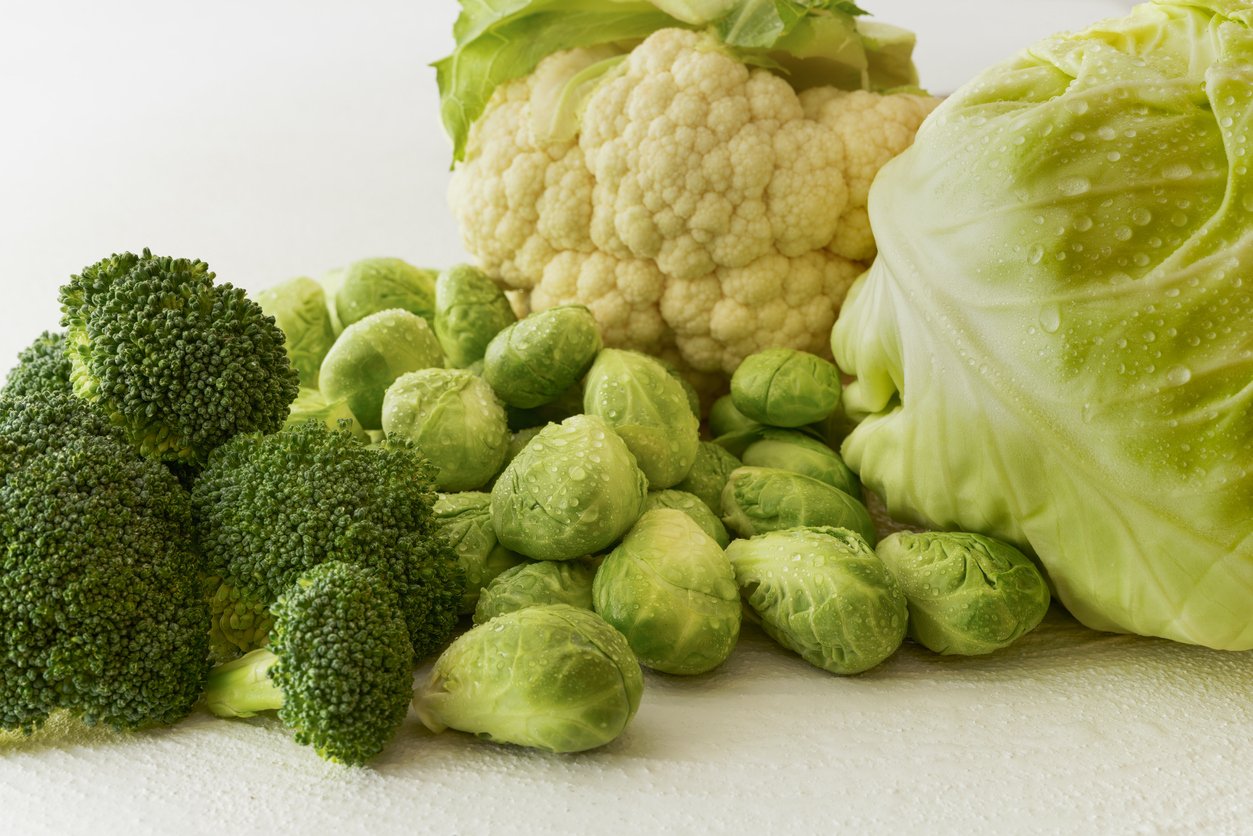
The word “cabbage” comes from the French word caboche, which means “head.” That makes sense given the shape. And the metaphor exists in English, where we talk about a head of cabbage.
The plant’s scientific name is Brassica oleracea. It’s related to other cruciferous vegetables, including broccoli, cauliflower, kale, bok choy, and Brussels sprouts, that belong to the same Brassica plant species.
Cabbage, as we know it today, is thought to have been domesticated from a wild ancestor in the Mediterranean by the Romans or the Celts. Thought to detoxify many bodily systems, cabbage served as a versatile tonic. Before people started eating cabbage, they prized it for its medicinal properties. Broth made with cabbage was used to treat various cancers, as well as to alleviate diarrhea, ulcers, gout, and headaches.
Types of Cabbage
You may be most familiar with red and green cabbage, but there are actually several additional varieties, including savoy and Chinese cabbage. The four main types include subvariations as well.
Let’s take a closer look at each of the major kinds of cabbage and some of their characteristic distinctions.
Green Cabbage
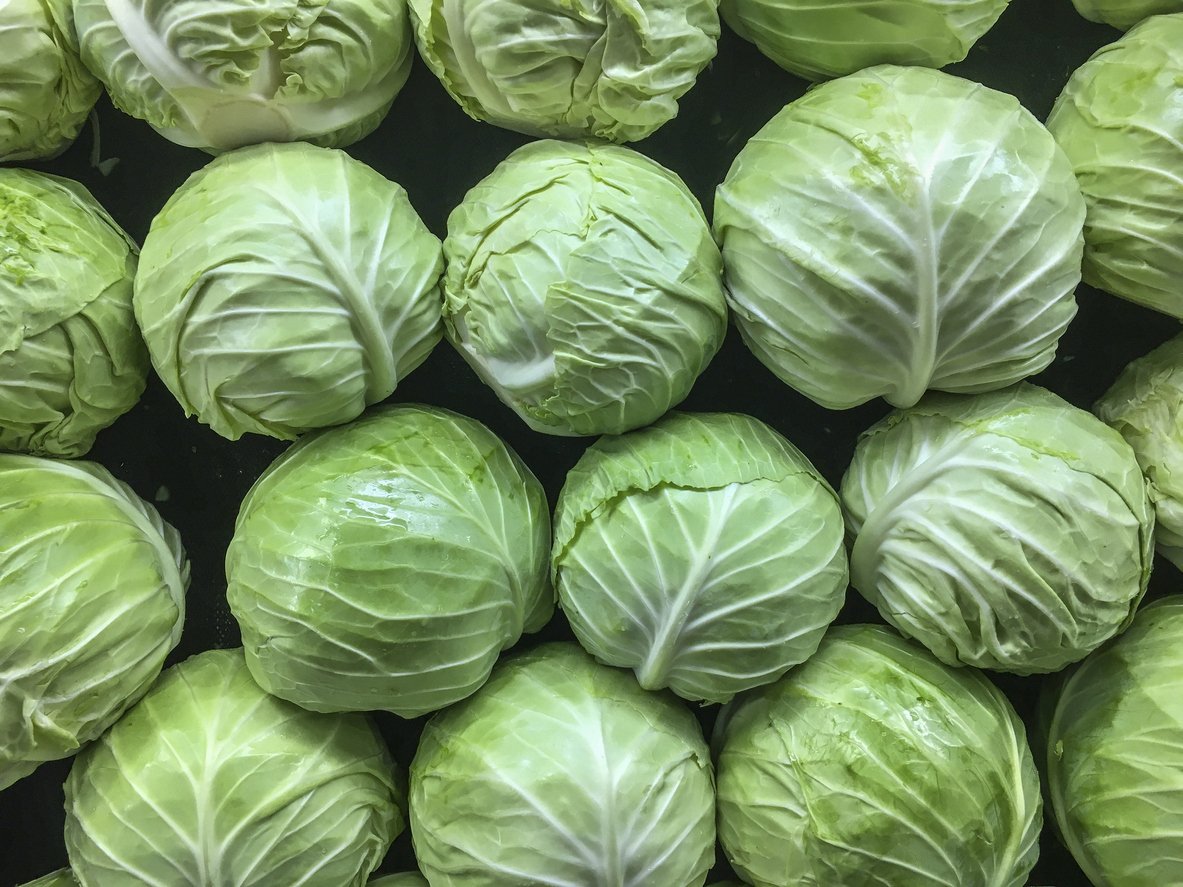
This is the most common type of cabbage, appearing with a green, pale green, or even almost white color. Its tightly-packed leaves have prominent veins and appear almost waxy on the outside. Green cabbage has a mustardy flavor that becomes sweeter and milder when you cook it. Green cabbage has a larger head than other types of cabbage. Some of the popular varieties of green cabbage include Cannonball, Early Jersey Wakefield, and Early Flat Dutch. (Happily, there are no historical instances that I could find of green cabbage actually being used as cannonballs, or any kind of weapon for that matter.)
Savoy Cabbage
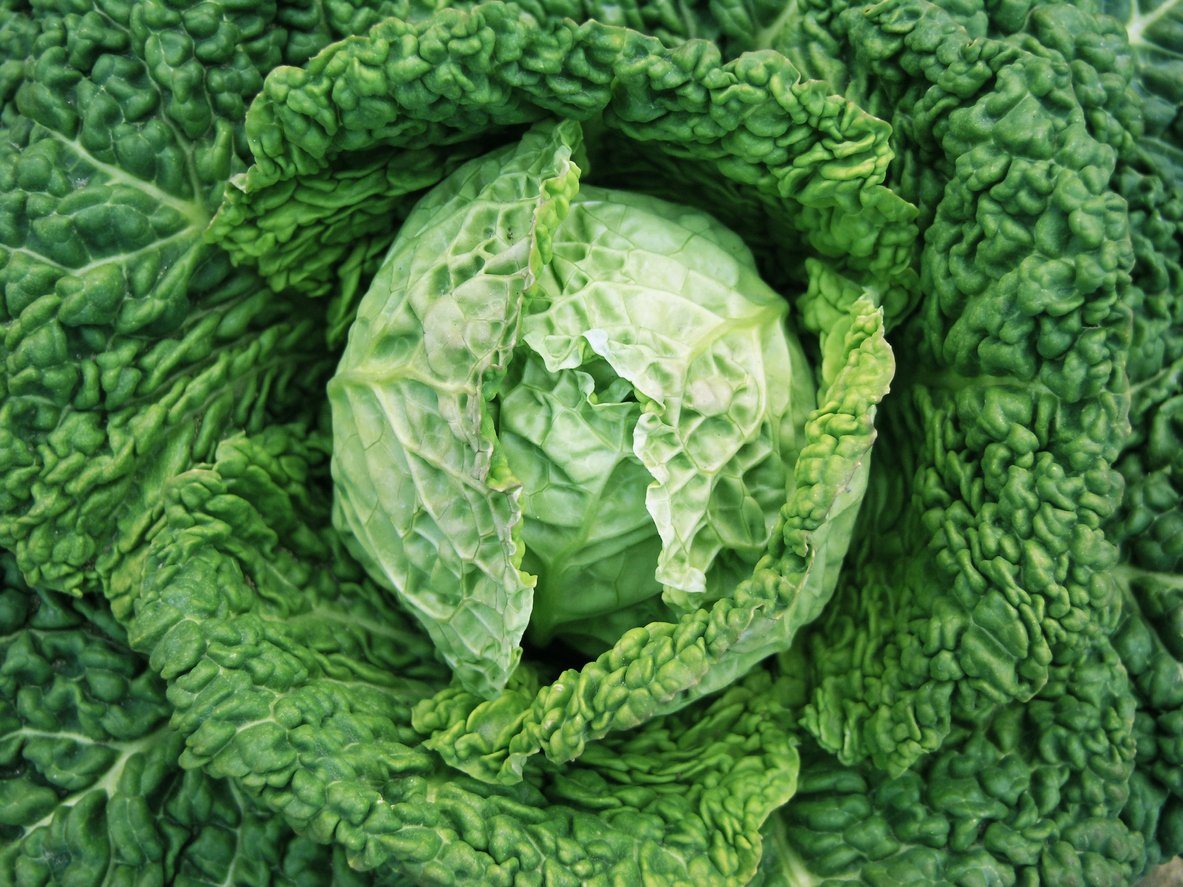
Savoy cabbage has a darker green color and features crinkly and crispy leaves. It also has a milder, sweeter flavor than many other cabbages. The leaves are not as compacted as green cabbage leaves. Basically, savoy cabbage looks like someone dressed up regular green cabbage for the prom. Popular varieties of savoy cabbage include Savoy King, Tundra, and Winter King.
Red Cabbage
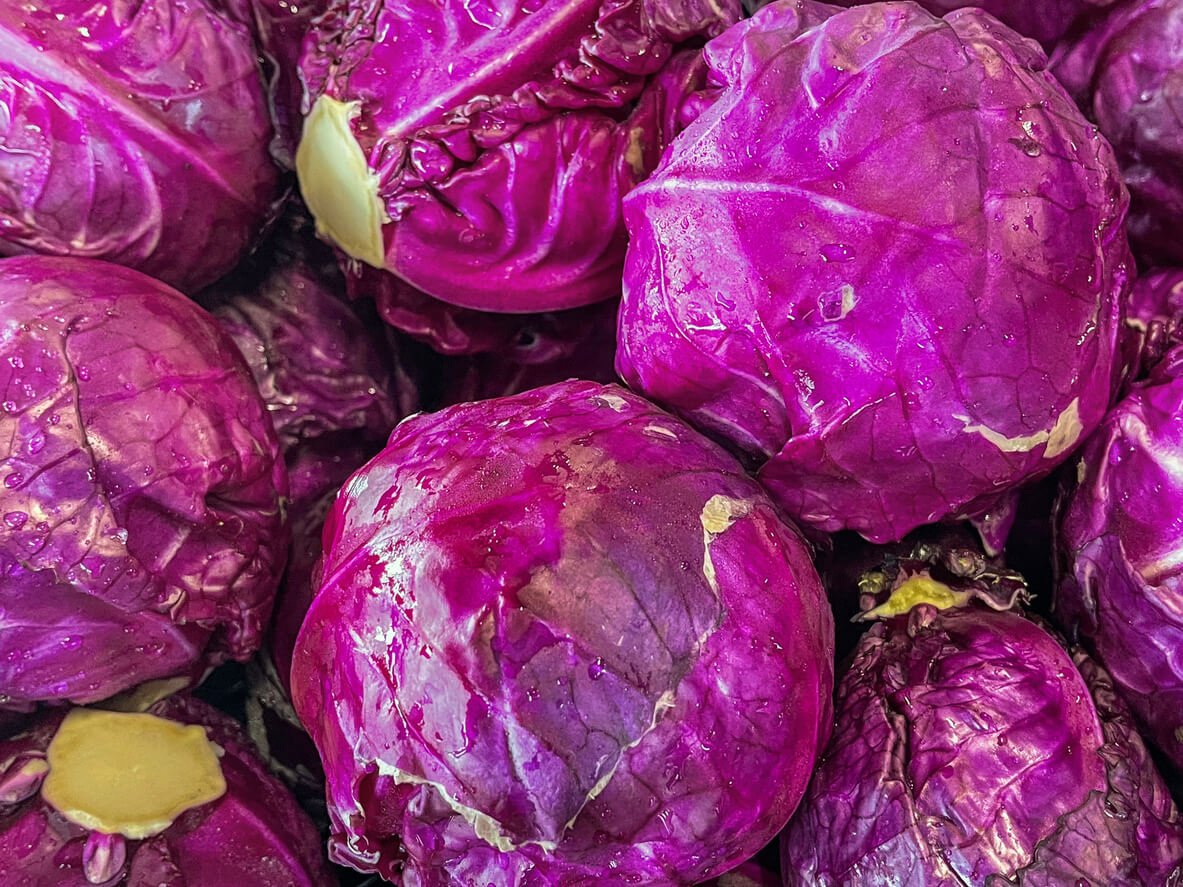
Red cabbage has a dark reddish-purple color with white veins. It offers a mildly bitter or peppery flavor, has dense and waxy leaves, and holds somewhat less water than other types of cabbage. Red cabbage is also slightly more nutrient-dense — its dark color indicates that it’s full of phytochemicals and antioxidants (particularly anthocyanins, which give plants their purple and red pigments). Because red cabbage contains compounds that change color based on pH, liquid from boiled red cabbage can make a fun science experiment. Some of the most popular varieties of red cabbage include Red Meteor, Ruby Ball, and Red Drumhead (which, sadly, seems to have never been used by a rock band.)
Chinese Cabbage

Chinese cabbages have an oblong shape, rather than the round heads of other varieties. They have thick stems, oval-shaped leaves, and fibrous stalks. Chinese cabbage is more commonly enjoyed cooked than raw, and has a mild to mustardy flavor range. Among the most popular varieties of Chinese cabbage are Napa and Baby Choi Sum.
Cabbage Nutrition Facts

One of the biggest reasons to add more cabbage to your diet is that it’s packed with nutrition. Cabbage is also a hydrating food, thanks to its generally high water content.
Most varieties of cabbage are good sources of vitamins C, K1, and B6, as well as folate, potassium, and manganese. Cabbage’s calories are low, but it’s also high in fiber, offering at least two grams per cup of chopped cabbage.
The nutritional value of cabbage, one cup raw chopped (Source: USDA):
- 22 calories
- 1.14g protein
- 2.22g fiber
- 35.6mg calcium
- 151mg potassium
Nutritional data of cooked cabbage, one cup boiled (Source: USDA):
- 34 calories
- .95g protein
- 1.42g fiber
- 36mg calcium
- 147mg potassium
Furthermore, a wide array of phytochemicals are in cruciferous vegetables like cabbage. For instance, those anthocyanins mentioned earlier are responsible for the reddish-purple coloring of red cabbage. Other phytochemicals include flavonoids, indoles, ascorbic acid, carotenes, and tocopherol.
Another compound found in cabbage is choline, which is not as easy to find in plant foods. Choline is an essential nutrient (meaning that our bodies can’t make it so we need to get it through our diets), and it’s important for healthy cells and metabolism, memory, mood, brain function, and muscle control. It’s so important, Dolly Parton wrote an entire song about — oh, hold on, I’m being told the title was, “Jolene,” so never mind.
Most cabbage varieties are also full of compounds called glucosinolates. These are precursors to sulforaphane, a bioactive compound in cruciferous veggies responsible for many of their health benefits. Sulforaphane and other sulfur-containing compounds in cabbage are responsible for giving cabbage its unique smell. But once you discover how sulforaphane can support your health, I hope you’ll agree that the smell is worth it!
Health Benefits of Cabbage
If you’re not yet convinced to make cabbage a bigger part of your diet, here are some of the incredible health benefits of eating cabbage.
Cabbage and Cancer: Anticancer Activity

Eating cabbage may help protect your cells against the development of certain cancers. Cabbage and other cruciferous veggies contain a compound called Indole-3-carbinol (I3C), which is so promising that it’s even sold as a dietary supplement (though why not skip the supplement and just eat the cabbage?). I3C can stimulate detoxifying enzymes in the liver and digestive tract. Cabbage often makes the list of vegetables for cancer patients after lab studies observed its ability to slow the growth of cancer cells.
Additionally, a 2021 case-control study among Polish-born migrant women in the United States found that a higher consumption of total and raw, lightly-cooked, or fermented cabbage during adolescence and adulthood was associated with a significantly lower risk for breast cancer. Interestingly, this population didn’t eat much cabbage that had been long-cooked, suggesting the possibility that these cancer-protective benefits may have something to do with the cabbage compounds preserved through short or no cooking times.
Cabbage Supports Liver Health

Many of the historical uses of cabbage in medicine come from its presumed detoxification properties. Research on cabbage today suggests that cabbage does in fact support the organ of detoxification, the liver, and may even help counter diseases of the liver by reversing oxidative damage.
A 2018 animal study published in Oxidative Medicine and Cellular Longevity found that consuming red cabbage for two months was able to reduce oxidative damage, help widen arteries, and trigger antioxidant pathways in rats with type 2 diabetes. Significantly, the red cabbage was able to reverse nonalcoholic fatty liver disease in the animals, offering hope that it might promise a similar benefit to humans. (Our view on the use of animals in medical research is here.)
Cabbage and Gut Health
Cabbage contains both soluble and insoluble fiber, which play different roles in gut health. Soluble fiber helps attach to LDL cholesterol particles and remove them from your system like tiny little Roombas (Roomba is a Jetson’s-worthy type of autonomous robotic vacuum cleaner), thus reducing overall cholesterol levels. Insoluble fiber acts sort of like a cleaner for the intestines (more like a low-tech scrubbing brush), removing waste and promoting bowel regularity.
Fermented cabbages, like those found in kimchi and sauerkraut, are rich in anti-inflammatory and immune-supportive nutrients, phytochemicals, and probiotic bacteria that are important for gut health. Fueling your good gut bacteria with fermented foods like these benefits your overall health and offers protection against a wide variety of chronic diseases. Brassica vegetables, like cabbage, seem to provide particular benefit to the gut microbiome.
Some people argue that cabbage is hard to digest, causing gas and digestion problems, especially if you don’t eat these foods regularly. Introduce cabbage to your diet slowly and in smaller amounts, and if you eat it regularly, you should see digestive issues lessen. I cover this in more depth down page, in Potential Downsides of Cabbage.
Cabbage Helps Regulate Blood Sugar

Eating cabbage may also be helpful for improving blood sugar regulation, especially in conditions like type 2 diabetes.
Evidence suggests that these benefits are thanks to bioactive compounds in cabbage that support normal glucose regulation and that reduce damage to organs that are often affected by complications of diabetes, like the kidneys and the liver. Some research also indicates that these compounds can address some of the underlying factors in the formation of type 2 diabetes, like obesity and oxidative stress.
Cabbage and Heart Health

Antioxidants in cabbage help prevent damage from oxidative stress in the body. This appears to be especially impactful when it comes to the heart.
Some research has shown that these compounds help prevent the dysfunction of mitochondria (the powerhouses of your cells, where energy is produced) involved in the cardiovascular system. Researchers in one study suggested that cabbage extract should be considered for its potential use as an alternative therapeutic strategy for reducing stress in the heart.
An animal study found that red cabbage microgreens improved how rats metabolized cholesterol. In the study, rats with diet-induced obesity were assigned randomly to one of a number of feeding groups for a period of eight weeks. Permutations included low- and high-fat diets, some supplemented with red cabbage microgreens and some with mature red cabbage. The microgreen supplementation was found to reduce diet-induced weight gain, as well as significantly lower LDL “bad” cholesterol levels in animals on the high-fat diet. This suggested that compounds in red cabbage may help regulate unwanted weight gain and keep unhealthy cholesterol levels in check, and therefore may offer some protection against heart disease.
Cabbage’s Anti-Inflammatory Effects
Inflammation is an important bodily process that protects our bodies from injury and infection. It’s only when inflammation is chronic (that is, constant and untreated), that it becomes not just problematic but actually a risk factor for numerous diseases. And unfortunately, chronic inflammation is widespread in industrialized countries today (largely due to a pro-inflammatory diet).
The good news is that including cabbage in your diet may reduce that chronic inflammation. One animal study found that cabbage extract applied topically to mice was successful for reducing skin inflammation. (Pro tip: if you don’t want mice to suffer from contact dermatitis, a method that doesn’t require cabbage involves not shaving their fur and then rubbing their skin with chemical irritants. Just sayin’… )
A 2016 randomized controlled trial found that wrapping cabbage leaves around the knees of people diagnosed with osteoarthritis — a painful inflammatory condition of the joints — resulted in a significant reduction in reported pain. Those who received the cabbage leaf wrap treatment had their knees wrapped in cabbage for a minimum of two hours per day for a total of four weeks.
Similarly, many women today also find that cabbage leaves can help reduce the pain and discomfort of breast engorgement during early periods of lactation. And while research has been mixed, there is some evidence that this is worth a try. For example, a 2012 review involving four studies concluded that such use of cabbage leaves was in fact able to reduce pain and hardness of engorged breasts, as well as increase how long women were able to breastfeed thanks to the reduced inflammation and discomfort.
Potential Downsides of Cabbage
While cabbage has numerous health benefits to offer, there may be some downsides to consider if you’re not used to eating it regularly.
Digestive Discomfort

Because cabbage is a concentrated source of fiber, it can cause digestive irritation for some.
Cabbage also contains raffinose, a compound found in beans, asparagus, certain grains, and other cruciferous vegetables. Raffinose is an oligosaccharide, or type of carbohydrate, that may trigger gas, bloating, and other somewhat annoying gastrointestinal symptoms. If you think cabbage smells bad going in, you may like it even less coming out.
Interestingly, raffinose is unique in that humans don’t have the enzyme, called α-GAL, that’s necessary to break it down. As a result, raffinose is fermented in the lower intestine by gas-producing bacteria that do have the α-GAL enzyme. This produces carbon dioxide, methane, and/or hydrogen — leading to the flatulence sometimes associated with eating cabbage. But don’t let this steer you away from eating cabbage. Raffinose is a beneficial compound itself, acting as a prebiotic that feeds the good bacteria in your gut.
Goitrogens

Cabbage contains other compounds called goitrogens, which it shares with all its cruciferous cousins (a great bluegrass band name, in my opinion). These naturally-occurring compounds can interfere with the uptake of iodine in some people, which could affect the function of the thyroid gland.
Dietary goitrogens, however, are not a concern for most people as long as they’re getting enough iodine and selenium in their diets. Plus, cooking foods that contain them destroys goitrogenic compounds.
While, theoretically, huge amounts of goitrogenic foods could trigger hypothyroidism (underactive thyroid), you’d have to base your diet almost entirely on raw cabbage and other Brassica vegetables for this to occur. Still, people who already have hypothyroidism or other thyroid health issues may want to make sure to cook cruciferous vegetables like cabbage to reduce goitrogens.
Pesticides in Cabbage

If you’re concerned about potential pesticide contamination in your cabbage, you’ll be happy to hear that cabbage is on the Environmental Working Group’s “Clean 15” list of fresh produce. This means that, through their testing, cabbage came out among the vegetables with the lowest residues of the main pesticides used in conventional farming.
Overall, some types of cabbage may have more pesticides than others. If you’re concerned, consider buying organic (or growing your own) whenever possible, to minimize the potential risk to your health and the health of the environment. But if you can’t afford or access organic cabbage, don’t let that stop you from eating and enjoying one of the healthiest foods in the world.
How to Choose & Store Cabbage

When searching for the perfect head of cabbage, here are some things to keep in mind.
First, look for solid, heavy heads or bunches of cabbage that don’t have yellowing leaves, splits, or soft spots, as these can all be signs of spoilage. Seek cabbages that have healthy-looking stem ends, meaning they’re free from soft spots, closely trimmed, and don’t appear to be drying out.
Cabbage leaves should be smooth and compact for green and red varieties but loosely packed for Chinese and Savoy varieties.
When you get your cabbage home, store it in a cool place to keep it fresh and retain vitamin C. Place the whole head of cabbage, unwashed, in a produce bag and keep it in the fridge for up to two weeks. Before you use it, remove any wilted or discolored outer leaves. Once you cut the head, put the rest of it in a storage container and use within three days for optimal freshness, texture, and flavor.
If you have cabbage leaves from a Chinese variety, store them in the fridge, unwashed. Rinse and dry them just before using. Don’t store wet greens, as this can create a moist environment ideal for bacterial growth and shorten shelf life.
And — while I love storing leftover chopped kale or spinach leaves in the freezer for things like sauces, soups, and smoothies — it’s not a good idea to put cabbage in the freezer due to its high water content, which will burst cell walls (and degrade the texture) as it freezes.
How to Prepare Cabbage
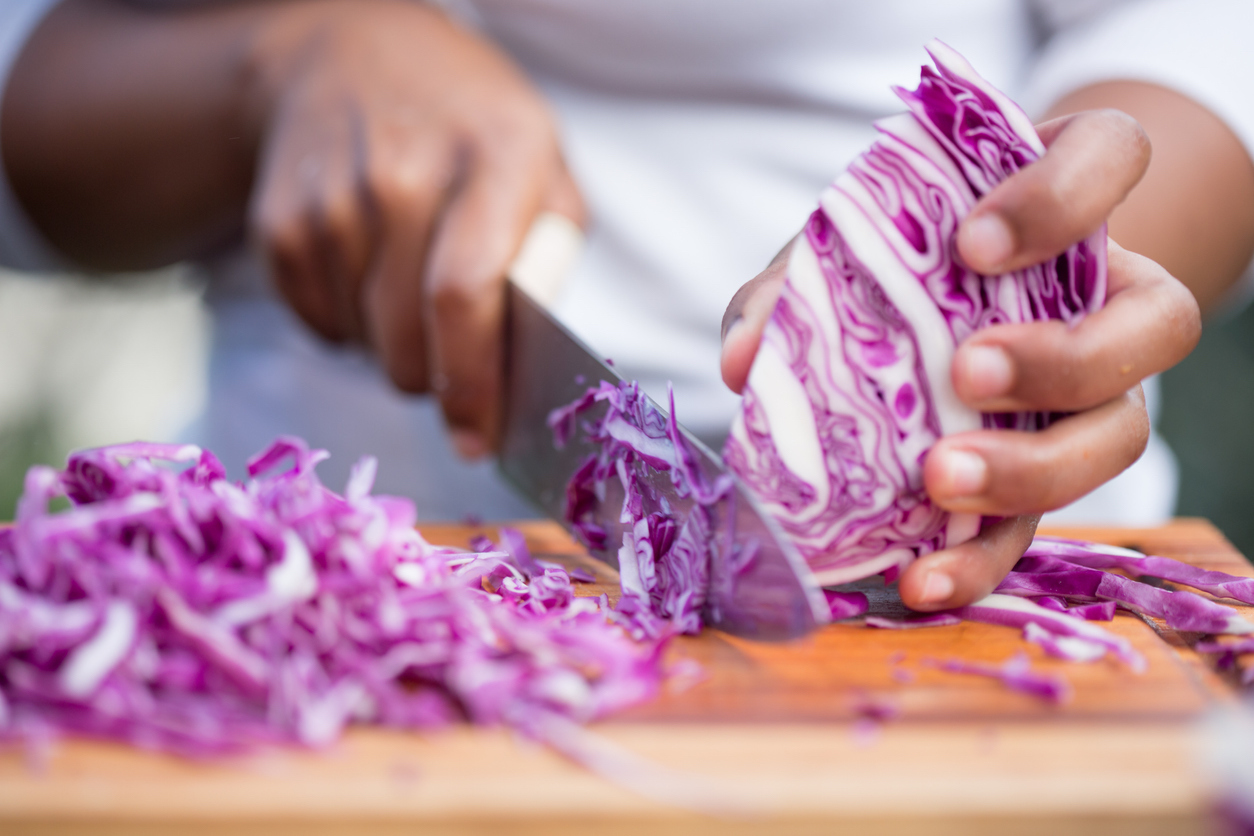
While whole cabbage leaves may not be the best choice for, say, layering a sandwich, most varieties can be served raw, cooked, or fermented for other delicious purposes.
Raw cabbage is great in chopped salads, coleslaws, stews, tacos, wraps, and even fresh-pressed juice or green smoothies. Plus, including some uncooked cabbage in your diet is a perfect way to reap the benefits of more sulforaphane. And you don’t have to go nuts with it. Even just a tablespoon of shredded raw cabbage can help activate the power of sulforaphane. (I know I’m on a roll here, but The Power of Sulforaphane sounds like a great name for a Transformers cartoon.)
If you enjoy fermented foods — which are amazing for digestive health and immunity — try fermented cabbage. The most popular ways to eat fermented cabbage are in the forms of kimchi and sauerkraut.
To cut a head of cabbage, begin by removing any outer leaves that appear damaged, wilted, or discolored. Then, slice the head in half, through the core. And for most uses, it’s best to remove the triangular-shaped core from the head. You can do this by cutting at an angle where the core meets the cabbage leaves, and removing this part from both halves. Next, place the cabbage cut-side down on a cutting surface, so the round side is facing up. Using your knife, slice the cabbage into thin half-moon pieces. From here, they’re ready for use in salads, coleslaws, and wraps.
If you’re using the cabbage for roasting, leave the core in to help hold the cabbage leaves together. Just trim some of the stem off the edge so that it’s not so prominent. After that, place the cabbage halves cut-side down and slice them into large wedges. Now, they’re ready to be cooked.
Watch a tutorial video on how to cut a head of green cabbage here:
How to Cook Cabbage
You can cook cabbage using any of the following methods:
- Boil: Slice cabbage into quarters or wedges and boil them in about a half-inch of water for 8–10 minutes.
- Steam: Cut cabbage into quarters and remove the core from each piece. Place them in a steamer basket in a pot filled with one inch of water. Steam for 6–8 minutes and then flip the cabbage wedges over and steam for another 6–8 minutes until crisp-tender.
- Bake: Slice cabbage into one-inch-thick rounds and place on a baking sheet lined with parchment or a silicone mat. Lightly coat with olive oil, salt, and pepper and bake at 400°F for 40–45 minutes, or until the edges are slightly golden and crispy.
- Grill: Cut a head of cabbage into four wedges, leaving the core intact. Place each wedge on heavy-duty foil lined with parchment paper and drizzle with olive oil and seasonings, like salt, pepper, and garlic powder. Fold the parchment and foil around each cabbage wedge and place on the grill, where you will cook them over medium heat for approximately 40 minutes until tender. Turn the cabbage 1–2 times while cooking to ensure an even cook.
- Stir-Fry: Add chopped cabbage, with cores removed, to a veggie stir-fry. Cook with water or vegetable broth over medium heat until tender. If you want to use a bit of oil, opt for one that has a high smoking point, such as avocado.
Keep in mind that water-based cooking methods, like boiling and steaming, result in some nutrient loss from the cabbage. However, you can retain some of these nutrients if you use the cooking liquid in something like a cabbage soup, or as the liquid for cooking a grain, rather than discarding it.
To reduce the smell of cooked cabbage, you can add an acid like vinegar or lemon juice. It’s also important not to overcook the cabbage, as boiling it too long can also contribute to a more prominent smell that some people find offensive.
Cabbage Recipes
Below you will find three different culinary techniques that incorporate three different types of cabbage. First, learn how to ferment in the comfort of your own home by making probiotic-rich Homemade Kimchi using napa cabbage. Next, enjoy red cabbage raw and shredded by diving into the (very pretty) Crunchy Cruciferous Slaw. Finally, feel like you’re dining out by making the Savory Bok Choy Stir Fry with rice and a heavenly garlic ginger sauce. Don’t forget to comment below to let us know about your cabbage recipe creating experience!
1. Homemade Kimchi
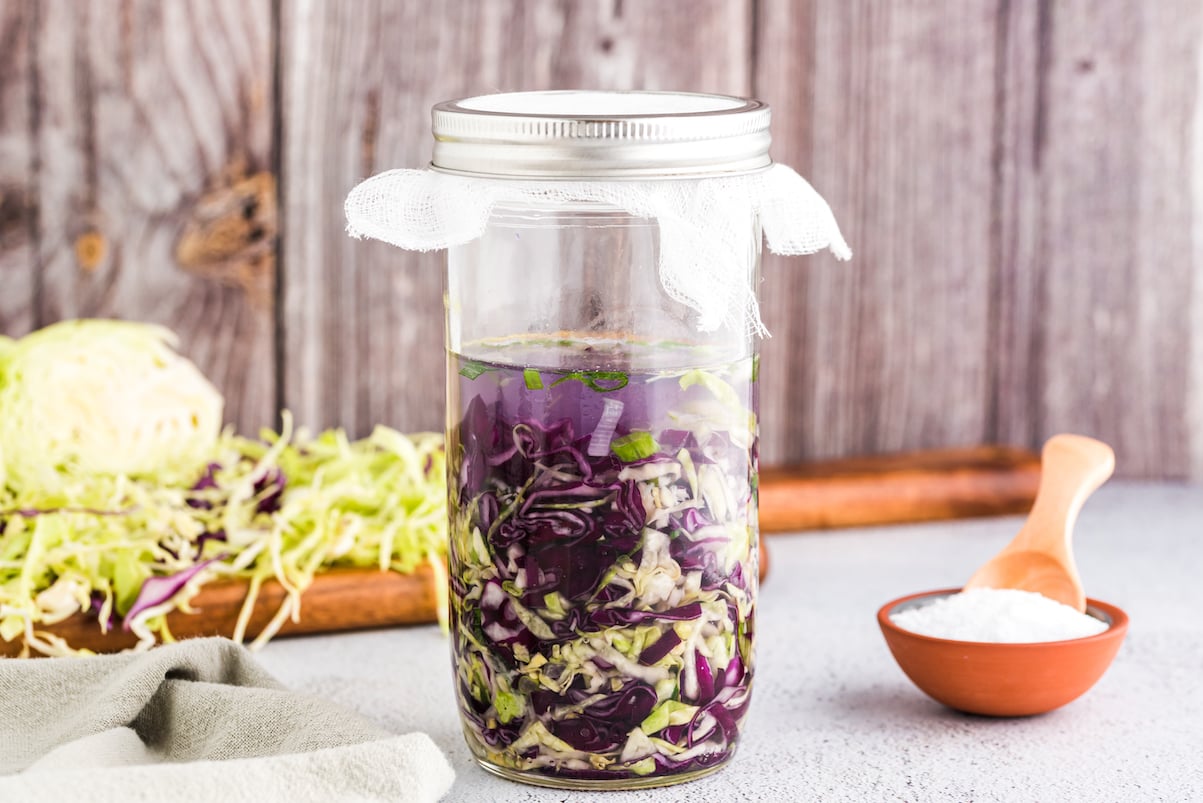
Kimchi is a traditional Korean dish made with fermented vegetables like napa cabbage or radish. Making your own kimchi takes only minutes to assemble, then simply requires a little patience while you let the vegetables undergo their transformation. The result is a flavorful homemade dish that’s packed with fiber, vitamins, AND healthy bacteria. Use this as a crunchy condiment in sandwiches, salads, or on top of avocado toast!
2. Crunchy Cruciferous Slaw
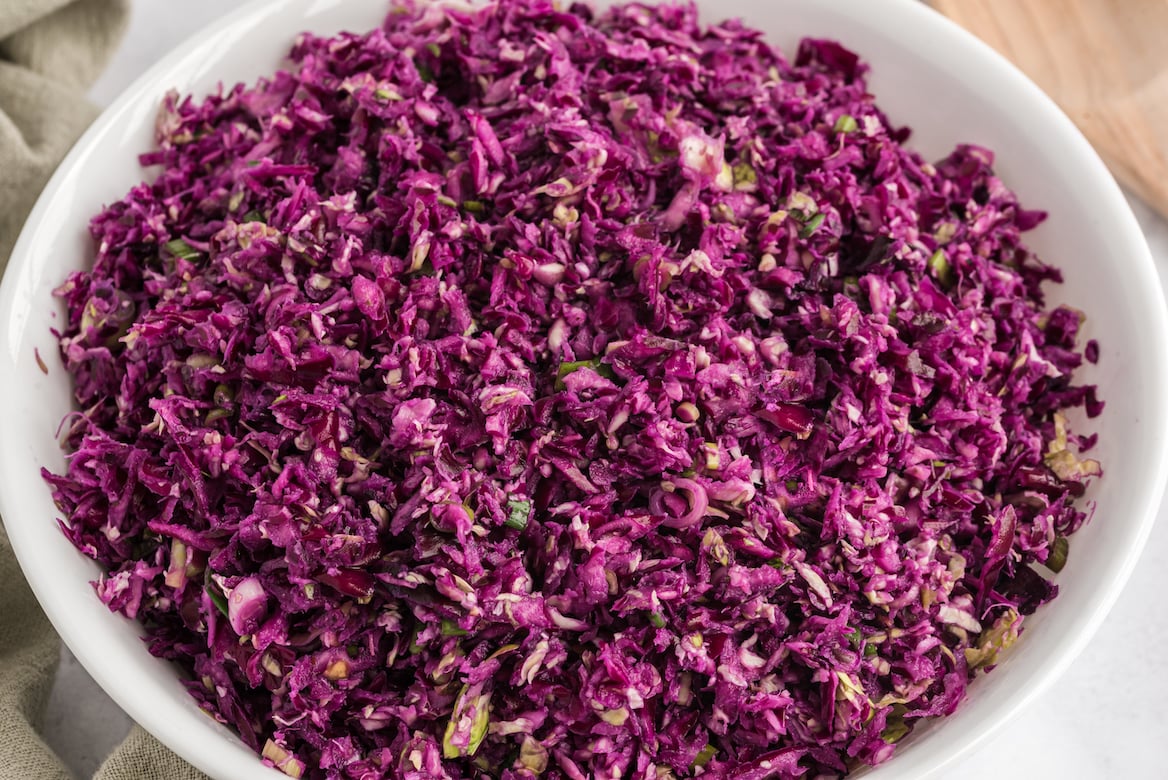
You might call this Crunchy Cruciferous Slaw the Purple Powered People Pleaser with its bright-colored hue, crunchy texture, creamy dressing, and healing attributes. Anthocyanin-rich red cabbage is the start of the show, while Brussels sprouts and red onion (more anthocyanins!) are supporting characters that lend additional flavor and nutrition. Enjoy this dish alongside a main meal, on top of a veggie burger, or as a crunchy snack!
3. Savory Bok Choy Stir-Fry
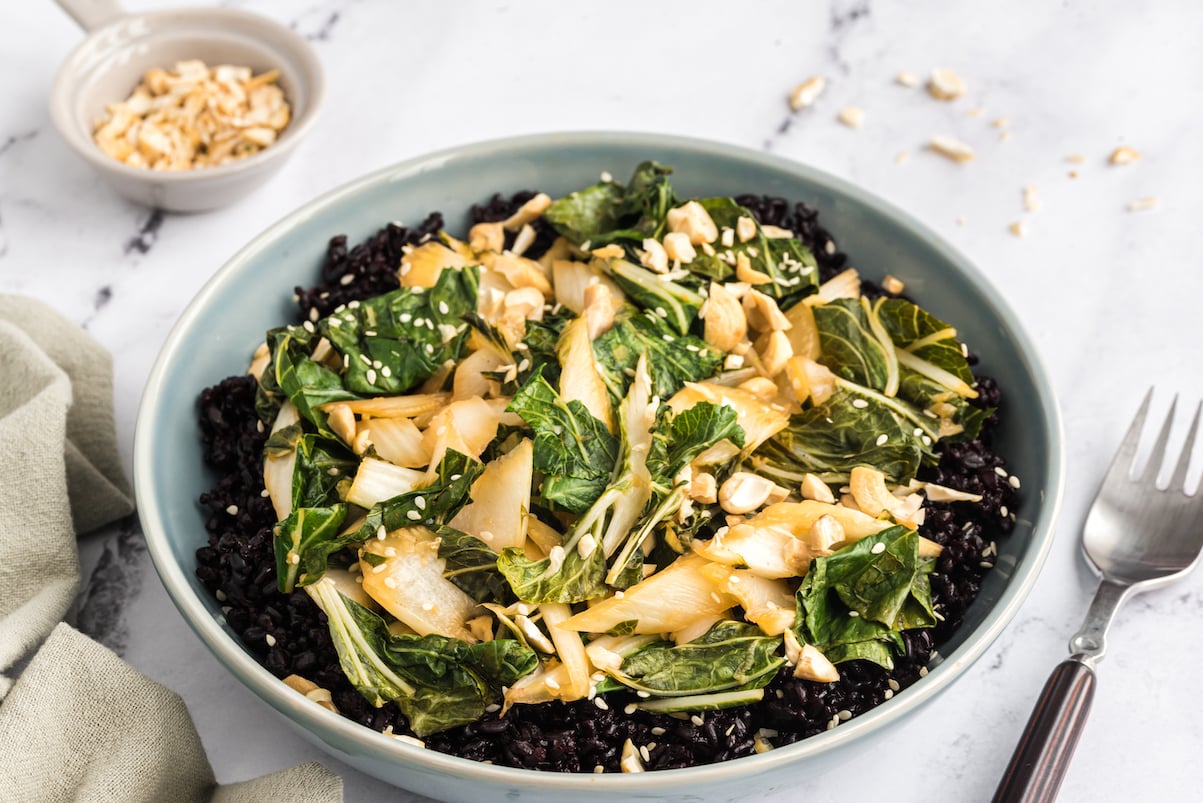
If you’ve traditionally banned cabbage from your kitchen due to its off-putting aroma, this restaurant-style Savory Bok Choy Stir-Fry might change your perception of this impressive veggie. Bok choy is milder in flavor and aroma compared to green cabbage, not to mention that it’s brimming with calcium. This dish is bursting with flavors and textures, as well as nutrition, from the cabbage, rice, ginger, and garlic.
Give Cabbage a Chance
Cabbage isn’t the most exciting vegetable at first glance. But if you give it a chance, it can be a versatile addition to your diet that can add myriad health benefits and nutrients. Plus, it’s one of the most affordable super-healthy foods that you can find at most grocery stores. Although there are a few potential downsides to eating cabbage for some, in general cabbage is a healthy addition to a balanced, whole foods diet. And, there are many ways to experiment with eating cabbage beyond just boiling it (many of which will also reduce the odor).
If more people knew what you now know, cabbages would be flying off the shelves like those 1980s Cabbage Patch Kids. For now, though, you can probably find all the cabbages you want, without lines, rationing, or arguments. So have fun getting to know cabbage and what it can do for your health!











































